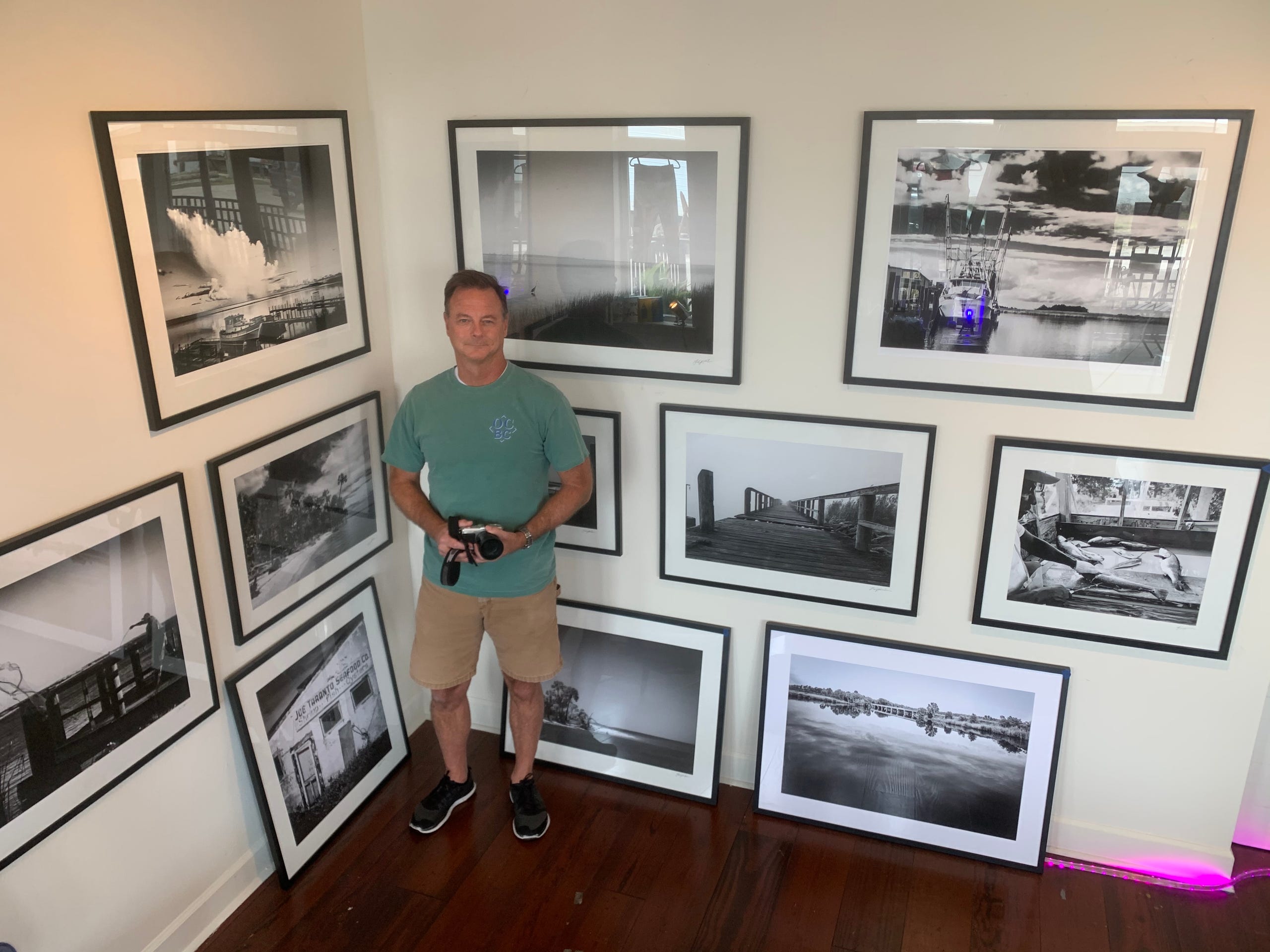Taranto Seafood in Apalachicola.
LARRY MCINTOSH
By and large photographer Larry McIntosh is known for his work with The MAD House, his advertising and design collaborative that traveled with him from Texas to northwest Florida. Although McIntosh is MAD House’s project and sales manager, he picked up photography skills from the creative teams who taught him the ins and outs of composition and lighting.
Though he wasn’t the one behind the lens at work, he was always watching and taking ideas home to his personal camera.
“Every day is a learning day for me,” says McIntosh, who is showing his photography for the first time at JOBA Gallery in Apalachicola co-owned by artists Jenny Odom and Beth Appleton.
As McIntosh dips his toes into the world of photographic arts, he hopes the exhibition, which runs through Dec. 19, might have people look at him in “A Different Light.” This is both the exhibition’s title and a nod to his black and white photographic style.
“I squeeze this in with my advertising business, so I’m not sure a lot of people know how much time I spend on it or even that I do it,” says McIntosh. “To have Jenny and Beth include me among their works is truly flattering.”

Larry McIntosh is showing his photography for the first time at JOBA Gallery in Apalachicola co-owned by artists Jenny Odom and Beth Appleton.
JENNY ODOM
His move to Apalachicola is what transitioned photography for him from a sometime hobby into a new creative outlet. The light and colors of the area spoke to McIntosh. He is always on the hunt for unique landscapes featuring older structures.
He captures these glimpses of “old Florida” in a clean, classic black and white style. McIntosh first learned to develop black and white film in high school.
“Sometimes color takes away from what you’re trying to do,” says McIntosh. “When it’s eliminated from the equation it helps people focus on the subject matter. Cracks and crevices in buildings or people’s faces.”
He took photos for the school yearbook and expanded his skills in college taking photography classes as an elective before starting his career. In 2005, he picked up his old digital camera in order to shoot in-house images for the ad agency.

Moon Shadow by Larry McIntosh.
LARRY MCINTOSH
He continued as a “hobbyist” for many years, dabbling in the editing process and posting his work on his social media pages. He donated his photographs to auctions for charitable causes and has photos available at a boutique in Apalachicola.
McIntosh was continually surprised by the amount of positive feedback he received both in person and online, which spurred him onwards. He looks up to black and white photographers like Ansel Adams and Florida landscape photographer Clyde Butcher for their mastery of the craft and ability to capture shades and shadows.
“My best shots are usually candid,” says McIntosh. “Something I see out of the corner of my eye will strike me. Maybe it’s a face or an expression. The way the clouds are hanging over the water or the way a boat is listing a certain way and sits against the background.”

The majority of his local photography features the history of Apalachicola’s fading seafood industry.
LARRY MCINTOSH
When McIntosh would drive from Austin to Atlanta to visit his parents, he often pulled over to take spontaneous shots of barns and farmhouses. He recently found a dinosaur-shaped gas station off old Highway 19 while photographing for a musician’s album cover.
The majority of his local photography features the history of Apalachicola’s fading seafood industry. Decomposing fishery storefronts stand starkly in overgrown grass. Doors hang lopsided in their frames. Abandoned boats shimmer in a grayish mist on the water, like spirits haunting a forgotten stretch of coastline.
“How much longer will those buildings be there and at what point will people forget what they were?” says McIntosh, who hopes these photos will also help others see the town in a ‘different light.’ “I would like people not from here to start thinking about Apalachicola in general as a place where there are artists that make amazing things.”
The exhibit will be open and free for viewing during regular gallery hours, with private tours available for those who call and request them. All visitors are asked to adhere to social distancing guidelines and wear masks inside the space. McIntosh is looking forward to what new opportunities this journey into fine arts photography may present.
“If we don’t create, we’re standing still,” says McIntosh. “During any time, but especially during lockdown especially when people are feeling hemmed in and stir crazy, if they can go and see things by people that are still out there taking photographs or creating artwork, that helps people through the process.”
Amanda Sieradzki




